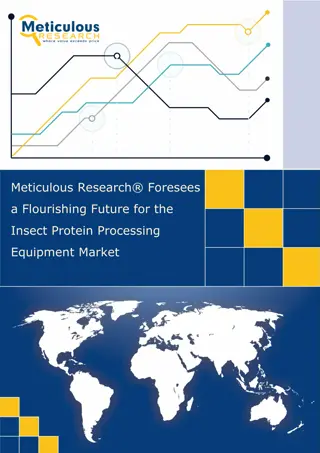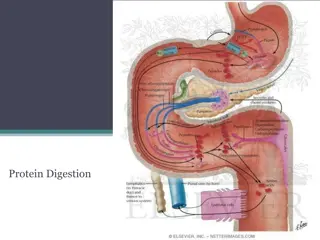Understanding the Integration of Carbohydrate, Lipid, and Protein Metabolism
The integration of metabolism involving carbohydrates, lipids, and proteins can be divided into three stages: hydrolysis to simpler units, preparatory stage, and oxidative stage. In the hydrolysis stage, complex polysaccharides, lipids, and proteins are broken down to simpler forms. The preparatory stage involves processes like glycolysis and fatty acid oxidation to produce energy. Amino acids undergo deamination and are metabolized in various ways. Energy is produced and stored as ATP during these metabolic processes.
Download Presentation

Please find below an Image/Link to download the presentation.
The content on the website is provided AS IS for your information and personal use only. It may not be sold, licensed, or shared on other websites without obtaining consent from the author. Download presentation by click this link. If you encounter any issues during the download, it is possible that the publisher has removed the file from their server.
E N D
Presentation Transcript
Integration of Metabolism of Integration of Metabolism of Carbohydrates, Lipids and Carbohydrates, Lipids and Proteins Proteins
The metabolic processes involving the three major food nutrients (carbohydrates, lipids and proteins )and their inter relationship can be broadly divided into three stages : 1st stage: Stage of hydrolysis to simpler units 2nd stage: Preparatory stage 3rd stage: Oxidative stage Aerobic final (TCA Cycle).
1st Stage Stage of Hydrolysis to Simpler Units The complex polysaccharides, starch/glycogen are broken down to glucose; and disaccharides are hydrolysed to monosaccharides in GI tract by various carbohydrate-splitting enzymes present in digestive juices. Similarly, principal lipids, triacylglycerol (TG) is hydrolysed to form FFA and glycerol. Proteins are hydrolysed by proteolytic enzymes to amino acids. Very little of energy is produced in this hydrolytic phase and it is dissipated away as heat. There is no storage of energy at this stage.
2nd Stage Preparatory Stage The monosaccharide glucose runs through the glycolytic reactions to produce the 3-C keto acid pyruvic acid (PA) in the cytosol, which in turn is transported to mitochondrion decarboxylation to produce 2-C compound acetyl-CoA ( active acetate). where it undergoes oxidative (gluconeogenesis) or by entering the same glycolytic pathway through the triose-P, forms PA and then finally 2-C compound acetyl-CoA The glycerol of fat, either goes into formation of glucose The fatty acids undergo principally -oxidation and form several molecules of acetyl-CoA .
The amino acids are deaminated/and/or transaminated first and the C- skeleton is metabolised differently from amino acid to amino acid Cysteine/Cystine and threonine when catabolised form pyruvic acid (PA) similar to carbohydrates and is finally converted to Acetyl CoA In the case of amino acids, eg. Glycine, Alanine, Serine, In the case of amino acids, eg. Glutamic acid, Histidine, Proline and OH- proline, Arginine and Ornithine produces -ketoglutaric acid when catabolised and thus they enter the TCA cycle
Yet a few others like Leucine, Phenyl alanine, Tyrosine and Isoleucine yield acetate or acetoacetate, the latter can be converted to acetyl- CoA . During the second stage (glycolysis, -oxidation, etc.) relatively small amount of energy is produced and this is stored as ATP.
3rd Stage Oxidative Stage: Aerobic Final (TCA Cycle) In presence of oxygen, acetyl- CoA is oxidized to CO2 and H2O by common final pathway TCA cycle. The carbohydrates, lipids and proteins all form acetate or some other intermediates like oxaloacetate (OAA), -ketoglutarate, succinyl-CoA, or fumarate, which are all intermediates of TCA cycle. Having gained entry into the TCA cycle at any site, two of carbons of citrate constituting an acetate moiety are oxidized finally to CO2 and H2O and the energy of oxidation by the electron transport chain is captured as energy-rich PO4 ATP mostly. This stage yields the largest amount of energy of all three stages
Three stages and their relationship with various amino acids
Interconversion Between The Three Principal Components I. Carbohydrates 1. Carbohydrates can form lipids: Through formation of: (a) -glycero-P from glycerol or di-hydroxy acetone- P (from glycolysis) which is necessary for Triacyl glycerol (TG) and (b) FA from acetyl-CoA-extra mitochondrial de novo synthesis.
2. Carbohydrates can form non-essential amino acids: Through amination of -ketoacids, eg. pyruvic acid (PA), oxaloacetic acid (OAA) and - ketoglutarate to form amino acids alanine, aspartate and glutamate respectively
II. Fats 1. Fatty acids can be converted to some amino acids by forming the dicarboxylic acids like malic acid, oxaloacetic acids and -ketoglutarate. 2. Fatty acid carbon may theoretically be incorporated into carbohydrates by the acetate running through TCA cycle. But there is no net gain in carbohydrates, since two carbons, equivalent of acetate are oxidised in the cycle. 3. However acetate can form glucose by running through the glyoxylate cycle.
4. Acetone, one of the ketone bodies may be glucogenic. Acetone can be converted to acetol-P which in turn can produce propanediol-P. Propanediol-(P) is glucogenic. III. Proteins Proteins can form both carbohydrates and lipids through the glucogenic and ketogenic amino acids. .























